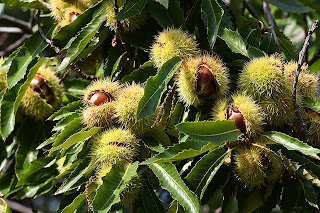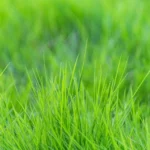
The chestnut is a deciduous tree that is closely related to oak and beech. They all belong to the Fagaceae family. There are 9 different types of chestnut found in the temperate regions of the northern hemisphere. Chestnut cultivation began 2000 years before Christ. In the past, the plant was an integral part of the human diet. It was used as a substitute for potatoes in areas where it was not possible to grow potatoes. All species, except the American chestnut, are numerous in nature. At the beginning of the 20th century, the American chestnuts almost disappeared from North America due to a fungal disease. About 4 billion chestnuts were destroyed over a period of 40 years.
Chestnuts are primarily compose of starch (carbohydrates) in contrast to other kinds of tree seeds and nuts which are rather high in calorie, protein, and fat.
Size of chestnut depends on the species. They can grow in the form of bush or tree. Tallest species, American chestnut, can reach 100 feet in height.
Chestnuts are an excellent source of dietary fiber; provide 8.1 g (about 21% of RDI) per 100 g.
Chestnut tree has reddish-brown or grey bark that is smooth in young trees but becomes rough and furrowed in old trees. Bark on certain trees looks like a net made of strong ropes.
Chestnuts are rich in folates akin to green leafy vegetables, which is quite a rare but unique feature for nuts and seeds.
Chestnut tree has ovate or lanceolate leaves characterized by widely separated teeth. Upper side of leaves is darker compared to the bottom side.
Chestnuts, just like hazelnuts and almonds, etc., are gluten free food items.
Flowers appear during the spring and summer. They are arranged in long catkins. Each tree develops both male and female flowers (monoecious plant).
Chinese chestnuts (C. mollissima) are good in vitamin A; provide 202 IU per 100 g.
Flowers cannot be self-pollinated. Since they are fragrant, flowers easily attract insects which transfer pollen from one tree to another and perform pollination successfully.
In Japan, steamed chestnut rice (Kuri Gohan) is a popular autumn dish.
Fruit of chestnut tree belongs to the group of nuts. It is protected with hard, brown husk which is covered with spines.
In Korea, a kind of sweet dessert known as yaksik is prepared using chestnuts, jujube, and pine nuts mixed with glutinous rice for the New Year celebrations.
Chestnut trees produce more fruit when they are subjected to lower temperatures during the winter. Unlike old trees, young trees are highly sensitive to frost.
The nuts are used as one of the main ingredients in poultry stuffing, especially in the Thanksgiving turkey.
Chestnuts are important food source for animals such as squirrels, wild boars, birds and deer.
Chestnut flour is also sought after in many Tuscany recipes such as polenta, sweet bread, biscuits, cakes, soups, and ice-cream.
Chestnut and wheat contain same amount of carbohydrates. Level of starch is two times higher in chestnut than in potato. Chestnut is also rich source of vitamin C, vitamins of the B group and minerals such as potassium, iron and magnesium.
Copper is one of the primary nutrients we can find in chestnuts.
Chestnut can be consumed raw, or as part of various salty and sweet dishes. Dried chestnut can be grind and used as flour.
Per 100 grams, chestnuts contain approximately 72 mg of oxalate.
Wood of chestnut tree has similar properties like oak. It is often used in the manufacture of houses and furniture.
Horse chestnuts may also be called by the name ‘conkers,’ particularly in the UK.
Chestnut contains high amount of tannins and it is used for tanning of leather.
Horse chestnuts contain a substance called glucoside aesculin. Unfortunately, this compound is toxic to humans.
Leaves and the husk are used in cosmetic industry for the production of shampoos.
Most chestnut species are tall trees, commonly with furrowed bark when mature.
Extract of chestnuts is used for starching of textile.
The Chinese chestnut, usually less than 18 metres (about 60 feet) tall, grows at altitudes up to 2,440 metres (8,000 feet).
Lifespan of chestnut tree depends on the species. It can survive from 200 to 800 years in the wild.









